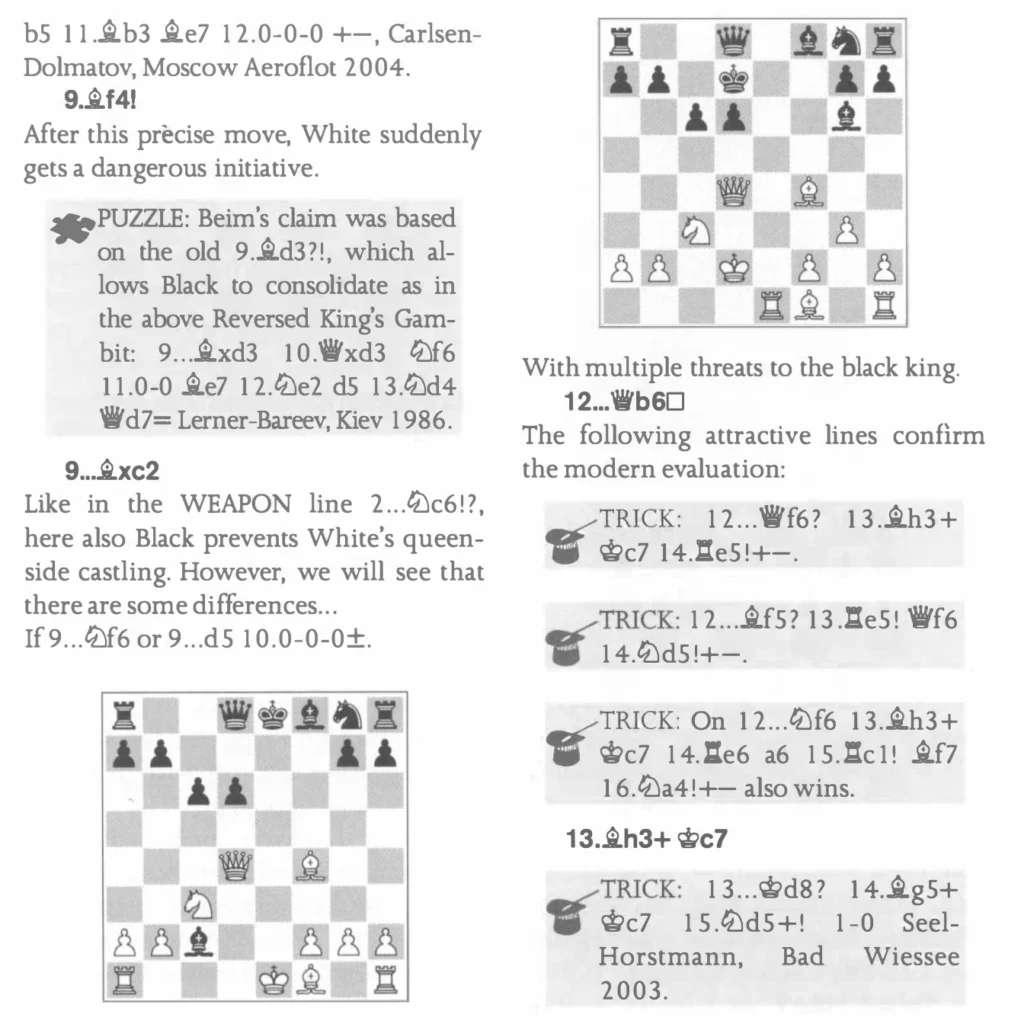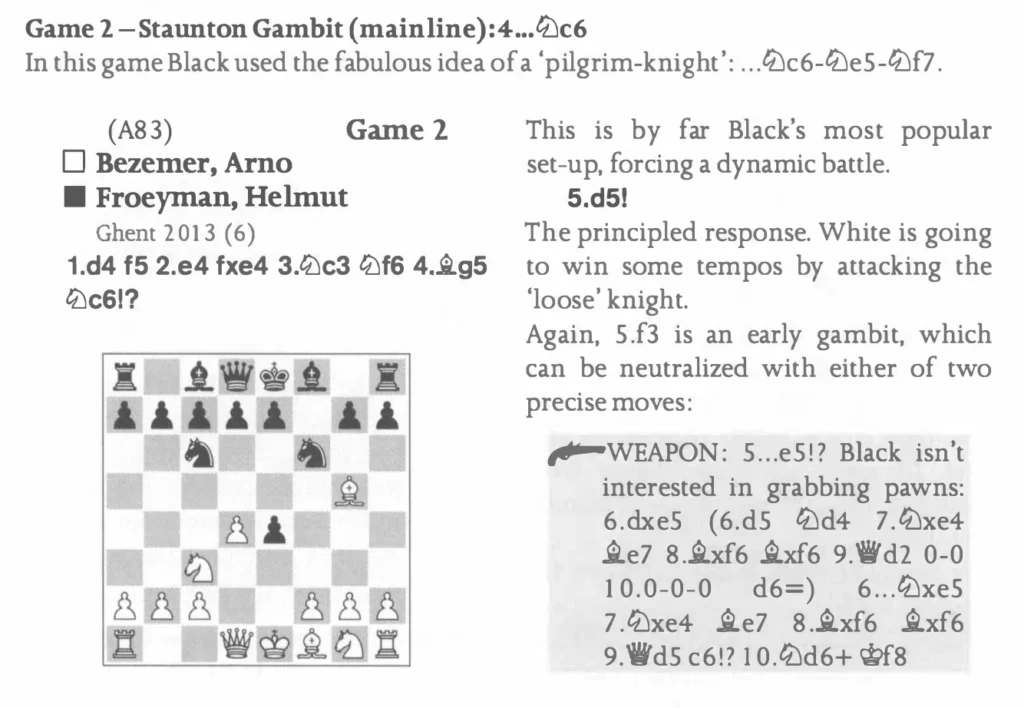Most opening books promise “dangerous ideas” or “powerful weapons.”
Very few actually deliver them in a way club players can use the next day.
The Diamond Dutch by GM Viktor Moskalenko is one of the rare exceptions.
With 300 pages of fresh plans, sharp weapons, humor, historical framing, and deeply practical model games, this book reshapes your understanding of the Dutch Defence from the ground up — not just memorizing lines, but understanding the soul of the opening.
If you play the Dutch — Leningrad, Stonewall, or Classical — or want to add it to your repertoire, this is one of the most complete, engaging, and inspiring guides available today.
Let’s break it down.
Quick Summary
Author: Viktor Moskalenko
Publisher: New in Chess
Pages: 300
Format: Paperback / Ebook
Focus: Anti-Dutch systems, Stonewall, Classical, Leningrad
Rating: 4.7/5 (Amazon), 4.5/5 (NIC shop)
This book teaches the Dutch as a living, evolving, unbalanced battleground rich with resourceful pawn structures and fresh attacking ideas.
It’s less about memorizing variations and more about:
- Why each idea works
- What structures matter
- How strong players actually win with the Dutch
- What to do when opponents avoid your main systems
Introduction: Why the Dutch? Why This Book?
The Dutch Defence has always attracted ambitious players — attackers, fighters, strategists who want imbalance from move one.
But it’s also been misunderstood: too wild for some, too much theory for others.
Moskalenko immediately disarms both concerns.
With historical context, practical setups, and lively commentary, he shows how the Dutch evolved from a 19th-century curiosity (Tartakower, Chigorin) into a modern weapon played by giants like Botvinnik, Bronstein, Petrosian, Larsen, Bareev, Short, Radjabov, and Kramnik.
The core message of the Preface is simple:
“The Dutch Defence has become a new gorgeous diamond in the treasure box of modern openings — full of resources and surprising ideas.”
This book is written to help you polish that diamond.

What You’ll Learn
1. How to Neutralize the Anti-Dutch
If you’ve ever groaned after 1.d4 f5 2.e4 or 2.♘c3 or 2.♗g5 — this book is your antidote.
Part I covers:
- Staunton Gambit
- Lisitsyn / Improved Lisitsyn
- 2.♕d3, 2.f4, 2.h3, 2.g4 (rare but dangerous)
- Knight System (2.♘c3)
- Bishop System (2.♗g5)
You’ll learn:
- Reliable defensive setups
- Counterattacks that punish early aggression
- The strategic logic behind Black’s best replies
This part alone is worth the price if Anti-Dutch lines have ever scared you off the opening.
2. Mastering the Stonewall Dutch
Part II is a complete education in e6–f5–d5–c6 structures.
What makes this section great:
- It’s not a data dump.
- It’s a practical, conceptual guide to how the Stonewall wins games.
Moskalenko teaches:
- The “classic castle”: where every piece goes and why
- What structures to aim for
- How strong players convert the kingside attack
- When the Stonewall is actually positional — not just a bash-on-the-king setup
Historical giants — Anderssen, Capablanca, Steinitz, Botvinnik, Petrosian — appear as part of the Stonewall lineage.
Modern specialists like Jussupow, Gleizerov, Ulibin, Agdestein, and Radjabov illustrate its continued relevance.
If you ever wanted a Stonewall manual that balances theory with real understanding, this is it.

3. Classical Dutch: A Practical Repertoire
The Classical Dutch (f5, e6, d6, …Be7) is covered with clarity and enthusiasm.
You’ll learn:
- Structures that resemble the French and Pirc
- When to aim for …Ne4, …d6–d5, or …c5 breaks
- Which move orders help you avoid tricky sidelines
- How to punish passive setups from White
Again, it’s not about memorization — it’s about learning plans you can reuse every game.
4. The Leningrad: The “Flying Fortress”
Part III is the sharpest and most dynamic section.
The Leningrad (f5, …g6, …Bg7, …d6) is presented as a flexible attacking weapon ideal for ambitious players.
Moskalenko covers:
- Main lines: …Nc6, …c6, …Qe8 systems
- Key pawn races
- When to launch …e5
- How to meet fianchetto systems
- The “Flying Fortress” — creative sidelines and new concepts
If you want a playable Leningrad repertoire without drowning in theory, this is one of the best introductions available.

Structure of the Book (Why It’s So Effective)
Each chapter follows a consistent, digestible teaching pattern:
- An original story or background anecdote
- Main ideas, resources, and model plans
- Deep but readable analysis
- Model games (55 in total)
- Illustrative games
- Statistics, summaries, and conclusions
This structure makes the book readable in any order — great for players who want to jump between lines depending on what they play.
Best Chapters (For Dutch Players Specifically)
1. The Knight System & Bishop System
Two of the most frustrating Anti-Dutch lines for club players. Moskalenko’s antidotes are practical and easy to remember.
2. Rolling Stones — Repertoire for Black and White
An underrated gem. He gives a playable repertoire for both sides, helping you understand what White wants, not just how Black survives.
3. The Main Leningrad: 7.Nc6, 7.c6, 7.Qe8
If you’re a Leningrad player, this is pure gold: a full, modernized survey with real game explanations, not database dumps.
4. Stonewall Updates
This is a Stonewall course inside the book — simple plans, new ideas, and fresh concepts in old structures.
Who This Book Is For
1. Dutch Defence Players (Any Level)
This is the target audience.
If you want a Dutch repertoire that’s fun, principled, and easy to maintain, this book is perfect.
2. Club Players Seeking an Unbalanced Fight
The Dutch gives Black immediate imbalance. Moskalenko teaches you how to use it safely.
3. Opponents of the Dutch
Even if you play White, this book teaches you:
- what systems are most annoying for Dutch players
- where Black’s structures crack
- when to punish …f5 or …g6 move orders
4. Coaches
Model games + clear plans = excellent teaching material.
Reader Experience (Based on Comments & Community Feedback)
From online discussions, Reddit threads, and Amazon reviews, several themes repeat:
“Finally a Dutch book that explains ideas, not just moves.”
“Moskalenko writes like a coach sitting next to you.”
“The Anti-Dutch section alone fixed half my problems.”
“I felt ready to play the Stonewall after one weekend with the book.”
“The humor and enthusiasm make it a joy to read.”
“If you love the Dutch, this is your new bible.”
Even players who don’t fully switch to Dutch say the book improved their understanding of:
- dynamic pawn structures
- kingside attacks
- how to play unbalanced positions
What I Liked Most
✔ The historical framing
You understand where the Dutch came from and why it’s respected.
✔ Model games with real lessons
No engine-perfect lines — just instructive, human games.
✔ Clear, memorable plans
Especially in Stonewall and Classical chapters.
✔ Practical Anti-Dutch coverage
A lifesaver for club players.
✔ Moskalenko’s voice
He is energetic, funny, direct, and encouraging — rare in opening literature.
What Could Be Better
✘ Lines occasionally get sharp
Some Leningrad chapters require engine checking if you want to memorize every detail.
✘ Not a complete repertoire
It’s a guide to strategies and weapons, not a strict move-by-move system.
Final Verdict
This is one of the best, most inspiring Dutch Defence books ever written.
Not just theory — understanding.
Not just variations — weapons you can use immediately.
Whether you play Stonewall, Leningrad, or Classical, The Diamond Dutch gives you a strategic foundation that lasts years.
And if you’re new to the Dutch?
This book shows you exactly why so many fighters love this opening.
Closing Note
👉 Ready to understand the Dutch Defence at a deeper strategic level? The Diamond Dutch will give you the plans, ideas, and weapons you need to play it with confidence. Buy The Diamond Dutch on Amazon, or The Diamond Dutch on Forward Chess here.

I’m Xuan Binh, the founder of Attacking Chess, and the Deputy Head of Communications at the Vietnam Chess Federation (VCF). My chess.com and lichess rating is above 2300. Send me a challenge or message via Lichess. Follow me on Twitter (X) or Facebook.






